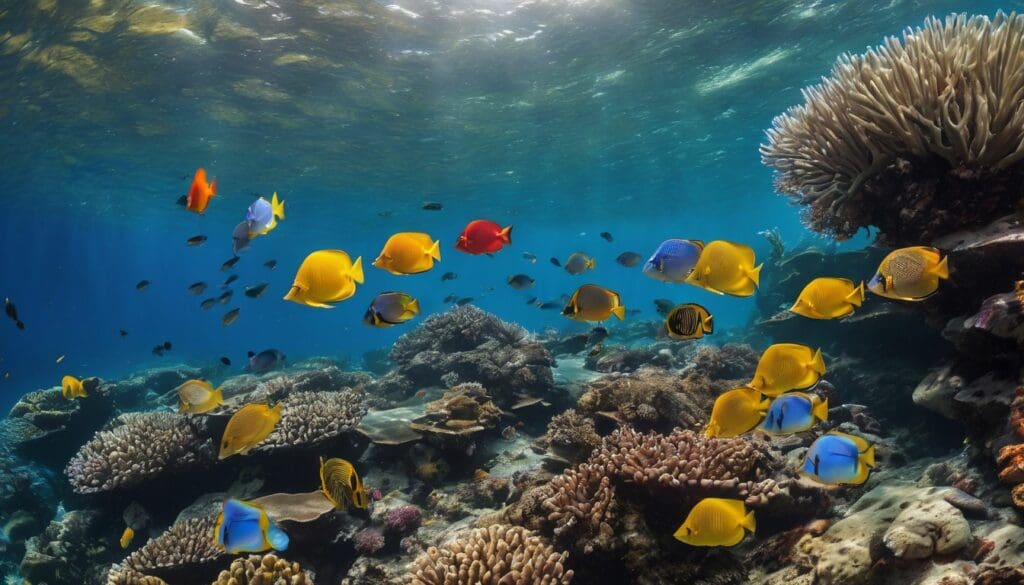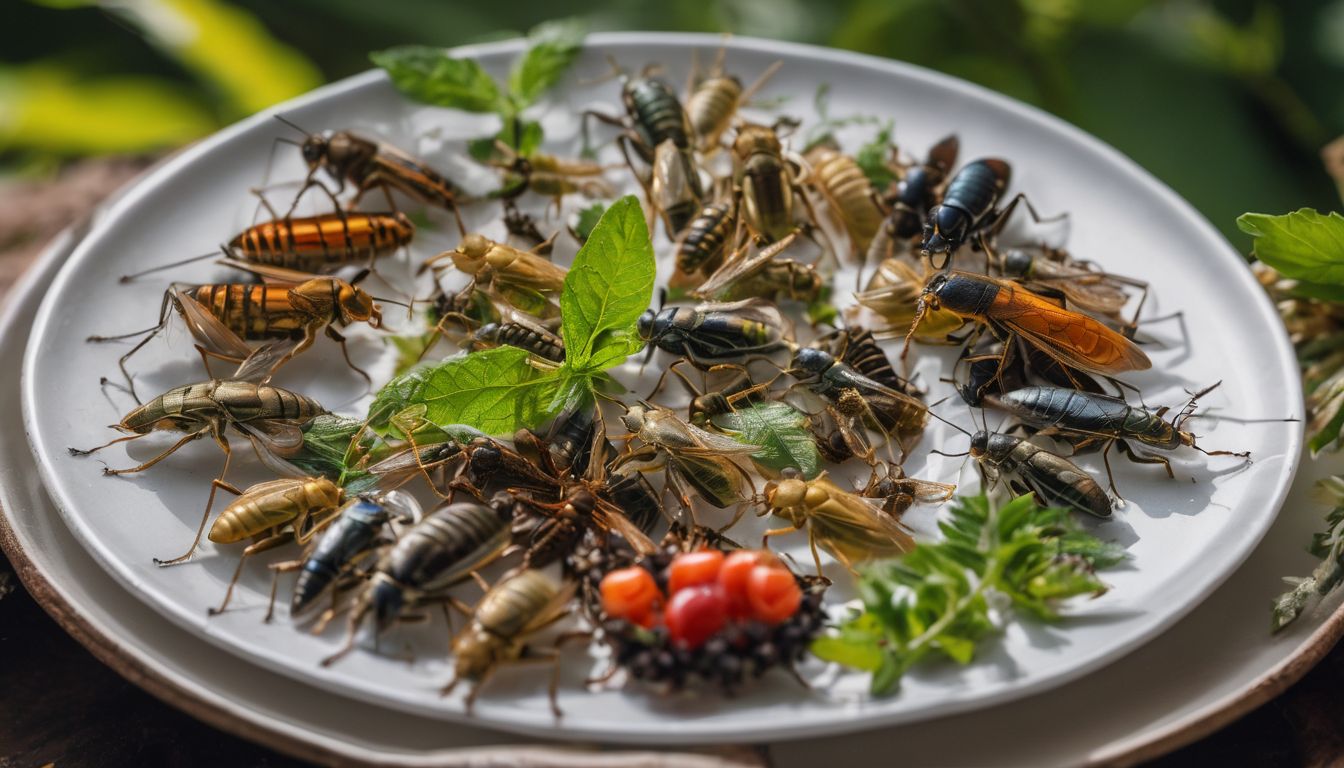Are you wondering how to enjoy seafood without harming our oceans? Every year, we eat more fish than the sea can naturally replenish. This guide promises easy steps to choose fish that’s good for you and kind to marine life.
Let’s dive in!
Key Takeaways
- Choose fish certified by the MSC or ASC to support environmentally responsible fishing and farming practices.
- Look for locally sourced fish options as they often have a lower carbon footprint and bolster local economies.
- Avoid red – rated seafood, which is identified as unsustainable, to help protect overexploited fish stocks.
- Pick seasonal fish when possible, embracing varieties like Alaska salmon and Pacific sardines that are abundant and sustainably managed.
- Consult with a knowledgeable fishmonger who can provide valuable insights into the most sustainable seafood choices available.
The Importance of Sustainable Fish Consumption
The global growth in fish consumption has put immense pressure on fish stocks, leading to overexploitation and environmental degradation. Understanding the impact of our seafood choices is essential for promoting sustainable fishing practices and protecting marine ecosystems.
Global growth in fish consumption
People around the world are eating more fish than ever before. This surge in demand has significant implications for marine conservation and ethical seafood sourcing. As populations grow and incomes rise, fish has become a key protein source for millions, driving up consumption rates.
Sustainable fishing methods must keep pace with this increased appetite to protect our oceans. Fish stocks are under considerable strain as overfishing threatens species diversity and ecosystem health.
Responsible seafood consumption now plays a crucial role in environmental responsibility, demanding that consumers make informed choices about the fish on their plates. Ocean-friendly fish choices support ecologically sound practices while fulfilling global dietary needs without depleting resources for future generations.
The impact on fish stocks
Overexploited fish stocks are a direct consequence of the global growth in fish consumption. This depletion is caused by excessive fishing, resulting in a decline in the population of various species.
The overfishing of certain species has led to imbalances within marine ecosystems and can have severe consequences for aquatic environments.
Environmentally responsible seafood management is crucial to address these impacts on fish stocks, as it aims to prevent overexploitation while promoting sustainable fishing practices.
The role of aquaculture
With fish stocks being overexploited, aquaculture plays a vital role in meeting the increasing global demand for seafood. Aquaculture involves the breeding, rearing, and harvesting of aquatic organisms under controlled conditions.
It helps to ease pressure on wild fish populations by providing an alternative source of seafood production. By promoting sustainable fishing methods and ethical sourcing of seafood, aquaculture contributes to conservation efforts and environmentally responsible seafood management.
Aquaculture also offers opportunities for research and innovation in sustainable fishing methods, ensuring ecofriendly fishing practices that support ocean-friendly fish consumption.
Tips for Responsible Fish Buying
When buying fish, always check for sustainable seafood guides and labels. Look for locally sourced fish and avoid red-rated seafood to make responsible choices.
Reading sustainable seafood guides and labels
When choosing seafood, look for sustainable seafood guides and labels to make informed decisions. These guides provide valuable information on the environmental impact of different fish species and help you select ocean-friendly options.
By checking labels, you can support ethical fish consumption while contributing to the conservation of overexploited fish stocks. Choosing ecofriendly seafood ensures that your purchase aligns with sustainable seafood recommendations, benefiting both marine ecosystems and future generations.
Check out our additional resources for more information on sustainable fish consumption and find ways to eat fish sustainably in line with ethical and environmental considerations.
Selecting from a safe list
- Look for Alaska salmon, which is sustainably managed and has a low impact on the environment.
- Consider Pacific sardines, known for their high abundance and quick reproduction rates.
- Try barramundi, a fast – growing fish farmed in closed systems that minimise environmental impact.
- Opt for Atlantic mackerel, a resilient species with healthy population levels and minimal bycatch concerns.
- Choose black cod (sablefish), which has well – managed fisheries and a low risk to marine habitats.
- Select albacore tuna from responsible sources like pole-and-line or troll-caught fisheries.
Buying locally sourced fish
When selecting from a safe list of sustainable seafood options, consider buying locally sourced fish. Local fish often have lower carbon footprints due to reduced transportation distances, supporting local economies and small-scale fishermen.
By choosing locally sourced fish, you can contribute to the sustainability of marine environments while enjoying fresh, ethically caught seafood.
Checking labels and nutritional information
When choosing seafood, it is essential to check the labels and nutritional information. Look for eco-labels such as MSC (Marine Stewardship Council) or ASC (Aquaculture Stewardship Council), which indicate sustainable and responsibly sourced fish.
Nutritional information can help you assess the health benefits of different seafood options, such as their omega-3 content and potential mercury levels. By being mindful of these details, you can make informed choices that support ocean-friendly fish and ethical seafood practices.
Next, let’s explore how to identify safe and sustainable fish from a recommended list when making responsible fish buying decisions.
Choosing frozen fish
When choosing frozen fish, look for options that are labelled as sustainable and ocean-friendly. Ensure that the packaging includes information about the species of fish and where it was sourced.
Opt for frozen fish that comes from well-managed fisheries or responsibly farmed sources to make ethical seafood choices. By selecting frozen fish from reputable suppliers, you can contribute to seafood sustainability while enjoying delicious and guilt-free meals.
Next, let’s explore the best sustainable fish species to consider for responsible consumption.
Avoiding red-rated seafood
Choosing sustainable seafood is important to protect our oceans and marine life. When selecting fish, avoid red-rated seafood, which indicates an unsustainable choice. By referring to sustainable seafood guides and labels, you can make informed decisions about what fish to buy.
Another tip for avoiding red-rated seafood is to opt for locally sourced fish, as this reduces the environmental impact of transportation. Checking labels and nutritional information can also help you make responsible choices when purchasing fish.
To further support ocean-friendly practices, consider choosing frozen fish instead of fresh options when they are not in season or from a sustainable source. These active steps towards avoiding red-rated seafood will contribute positively to the health of our oceans and marine ecosystems.
Choosing Sustainable Fish Species
Selecting from a variety of sustainable fish species, including Alaska salmon and Pacific sardines, can help support responsible fishing practices and ensure the health of our oceans.
To learn more about making ethical choices when it comes to seafood consumption, read on for additional tips and resources.
Alaska salmon
Alaska salmon, known for its rich flavor and vibrant color, is a popular choice for environmentally conscious individuals. It’s not only delicious but also a sustainable option as it comes from well-managed fisheries.
Choosing Alaska salmon supports responsible fishing practices and helps maintain healthy fish populations in the ocean. This sought-after fish is an excellent source of omega-3 fatty acids and high-quality protein without compromising environmental integrity.
When selecting your seafood at the market or grocery store, keep an eye out for wild-caught Alaska salmon to ensure you’re making an ocean-friendly choice that aligns with ethical and sustainable fish consumption.
Pacific sardines
Pacific sardines are a sustainable choice for environmentally conscious consumers. These small, oily fish are abundant and reproduce quickly, making them resilient to fishing pressure.
Sardines also play a vital role in the marine food web, providing food for larger predatory fish and marine mammals. Rich in omega-3 fatty acids and low in contaminants, Pacific sardines offer a healthy and eco-friendly option for seafood lovers.
Sourcing Pacific sardines from well-managed fisheries supports conservation efforts and promotes ocean-friendly fish consumption. With their small size but big impact on the environment, choosing Pacific sardines aligns with the principles of ethical and sustainable fish consumption, benefiting both marine ecosystems and personal health.
Barramundi
Moving from sustainable Pacific sardines to barramundi, consider choosing this fish for its low environmental impact. Barramundi is a popular choice among environmentally conscious consumers due to its sustainability and excellent taste.
Also known as Asian sea bass, barramundi is farmed in closed-loop systems which significantly reduces the risk of pollution and disease spread.
The farming of barramundi often takes place in land-based tanks or ponds, providing a controlled environment that minimises the impact on ocean ecosystems. When selecting fish for your meals, barramundi stands out as a responsible choice both environmentally and ethically due to its minimal ecological footprint.
Atlantic mackerel
Having explored the sustainability of Barramundi, it’s important to consider Atlantic mackerel as another ocean-friendly fish option. Rich in omega-3 fatty acids and low in mercury, Atlantic mackerel is a sustainable choice for environmentally conscious consumers.
This small, oily fish can be found abundantly in the North Atlantic and is often recommended by seafood guides due to its stable population levels and minimal impact on marine ecosystems.
When selecting seafood, choosing Atlantic mackerel supports conservation efforts while providing essential nutrients for your diet. Whether grilled, smoked, or pickled, this versatile fish offers a delicious and ethical addition to your culinary repertoire.
Black cod or sablefish
When considering sustainable fish species, black cod or sablefish are an excellent choice for environmentally conscious consumers. These deep-sea fish have a delicate, rich flavour and a silky texture that makes them highly sought after.
Black cod is not only delicious but is also considered an ocean-friendly option as it is responsibly harvested and managed in the wild. When purchasing black cod, look for sustainably sourced options, such as those certified by organisations like Marine Stewardship Council (MSC) or Seafood Watch.
Black cod’s slow growth rate makes it more resilient to fishing pressure compared to faster-growing species, contributing to its sustainability. Additionally, the white flesh of black cod is packed with omega-3 fatty acids and essential nutrients that make it a healthy choice for conscientious consumers looking to support conservation efforts while enjoying their seafood dishes.
Albacore tuna
Albacore tuna is a sustainable choice due to its short lifespan and high reproductive rate, making it less vulnerable to overfishing. When purchasing albacore tuna, look for labels indicating pole-and-line or troll-caught methods, which are considered more environmentally friendly.
Remember to check guidelines from marine conservation organisations when selecting canned albacore tuna. Buying sustainably sourced albacore tuna helps support responsible fishing practices and the long-term health of ocean ecosystems.
Next up: “Ways to Eat Fish Sustainably”
Ways to Eat Fish Sustainably
Embracing seasonal eating allows for a variety of fish to be enjoyed at their peak freshness. Making sustainable swaps, such as choosing lesser-known species or opting for plant-based alternatives, is another way to promote responsible fish consumption.
Engaging with a knowledgeable fishmonger can also provide valuable insights and recommendations for sustainable seafood options.
Embracing seasonal eating
Incorporating seasonal fish into your diet promotes sustainability and benefits the environment. Choosing fish that are in season supports local fisheries, reduces carbon footprint from transportation, and ensures you’re enjoying the freshest produce.
By embracing seasonal eating, such as opting for mackerel during its peak season or selecting sardines when they are abundant, you are actively participating in sustainable consumption practices.
Embracing seasonal eating aids biodiversity protection and promotes responsible fishing practices. It allows different species to repopulate naturally while reducing overfishing pressures on specific stocks.
Making sustainable swaps
Swap out overfished species like tuna and swordfish for sustainable options such as Pacific sardines, barramundi, or albacore tuna. Consider trading in large predatory fish for smaller species with shorter lifespans to reduce the impact on ocean ecosystems.
Opt for locally sourced fish instead of those imported from great distances to lower your carbon footprint and support local fishing communities.
When making sustainable swaps, choose frozen fish when fresh is unavailable – this preserves the quality without compromising nutritional value. Embracing seasonal eating by selecting fish that are abundant during specific times of the year also contributes to sustainable consumption practices.
By working with a trusted fishmonger who supports ethical and responsible sourcing, you can ensure that your purchases align with conservation efforts.
Working with a fishmonger
When buying fish, working with a trusted local fishmonger can provide valuable information on the sourcing and sustainability of the seafood. Engaging with a knowledgeable fishmonger who prioritises ethical and sustainable practices ensures that consumers are making informed choices about their fish purchases.
The expertise of a reputable fishmonger helps in selecting ocean-friendly fish species and understanding their seasonal availability, contributing to responsible and environmentally conscious consumption.
By building a relationship with a reliable fishmonger, individuals can support conservation efforts while enjoying delicious and sustainable seafood options.
Final Thoughts and Additional Resources
In conclusion, making sustainable fish choices is crucial for supporting healthy oceans and marine ecosystems. By following the tips outlined in this guide, consumers can play a vital role in promoting ethical and sustainable fishing practices.
Remember to refer to seafood guides and labels, opt for locally sourced options, and choose from safe lists when purchasing fish. Embracing seasonal eating and working closely with a trusted fishmonger are other ways to ensure environmentally friendly consumption.
For additional information on sustainable seafood, explore the resources provided at the end of this guide.





